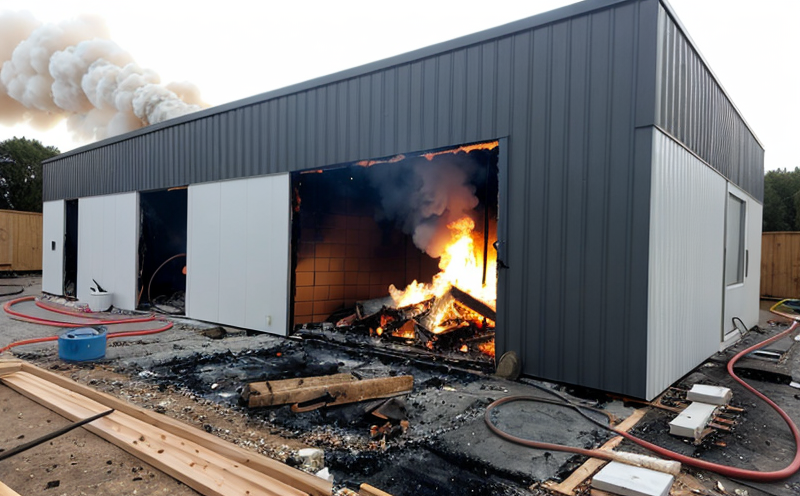Insulation & Cladding Fire Testing
The Insulation and Cladding Fire Testing service is essential in ensuring the safety of buildings by evaluating materials used in these critical components. This testing is particularly important for fire safety, as it directly impacts the structural integrity and occupant safety during a fire event. Properly tested insulation and cladding can prevent the spread of fire through walls and roofs, which could otherwise lead to catastrophic failure.
Testing involves subjecting specimens from actual or representative materials used in building envelopes to controlled flame exposure conditions. The objective is to determine the material's resistance to ignition and its ability to maintain structural integrity under fire exposure. This testing helps architects, builders, and safety regulators make informed decisions about product selection and design.
The process begins with detailed specimen preparation, ensuring that each sample accurately represents the intended application in a real-world scenario. Once prepared, specimens undergo rigorous flame exposure tests, which can vary based on specific industry standards such as ASTM E1360 or EN 13826, depending on regional requirements.
After testing, our team provides comprehensive reports detailing test results, including data on ignition temperature, heat release rate, smoke production, and structural integrity. These reports are crucial for compliance with local building codes and international standards like ISO/IEC 17025, which ensures the laboratory maintains high-quality testing practices.
Our expertise in this field extends to providing advice on material selection based on fire performance data, helping clients navigate complex regulations effectively. We also offer training sessions for internal teams responsible for quality assurance and compliance, ensuring they are up-to-date with the latest testing methodologies and standards.
Applied Standards
| Standard Number | Description | Scope | Key Requirements |
|---|---|---|---|
| ASTM E1360-18 | American Society for Testing and Materials Standard for Determination of Fire Resistance of Building Assemblies. | Determines the ability of a building assembly to sustain structural integrity, resist fire penetration, or both in specified time periods under standard fire test conditions. | Test specimens are subjected to controlled flames and heat until they fail. Results include duration of resistance and percentage of failure. |
| EN 13826:2014 | European Norm for Fire Resistance Testing of Building Elements. | Similar scope as ASTM E1360 but tailored to European market needs. Includes more detailed requirements regarding test conditions and reporting. | Involves exposure of specimens to fire until failure, measuring the time taken for structural integrity to be compromised or for flames to penetrate. |
| ISO 9702:2016 | International Standard for Fire Resistance Testing of Building Elements. | Aims at ensuring consistency in testing methodologies across different countries. Provides a framework for conducting fire resistance tests on building elements. | Details the procedures, apparatus, and evaluation criteria necessary for conducting reliable fire resistance tests. |
Environmental and Sustainability Contributions
- Reduces carbon footprint by ensuring materials meet stringent safety standards without compromising on quality.
- Promotes sustainable building practices by providing data that can be used to select fire-resistant insulation and cladding for new constructions or retrofits.
- Aids in regulatory compliance, thereby reducing the likelihood of costly fines and delays during construction projects.
- Enhances public safety through rigorous testing protocols that ensure buildings remain structurally sound under extreme conditions.
The environmental benefits of effective fire testing are significant. By ensuring materials meet high standards before they reach market shelves or construction sites, we help minimize the risk of fires spreading rapidly and causing extensive damage. This not only protects lives but also reduces insurance premiums for property owners who have tested materials compliant with these stringent standards.
Use Cases and Application Examples
| Application Example | Description | Test Conditions | Expected Outcomes |
|---|---|---|---|
| New Residential Housing Developments | Evaluating the fire resistance of insulation boards used in residential housing. | Specimens exposed to controlled flames for a specified duration. Heat and smoke release measured using specialized equipment. | Data on ignition temperature, flame spread, smoke production, and structural integrity after exposure. |
| Commercial Buildings | Determining the fire resistance of cladding used in commercial buildings to comply with local regulations. | Similar to residential testing but tailored to larger scale building components. Additional focus on wind load effects. | Data on structural integrity, flame spread rates, and compliance with specific regional codes. |
| Retrofitting Existing Buildings | Evaluating the fire performance of existing insulation or cladding materials as part of a retrofit project. | Specimens tested under conditions that mimic real-world exposure. Comparison made against new material standards. | Data on compatibility with new systems, potential improvements in fire resistance, and cost-effectiveness of upgrades. |





